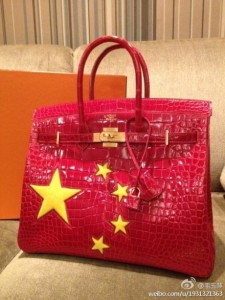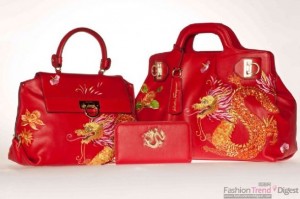It is not surprising to see China becoming the largest market for luxury goods. According to a recent article on Sina Finance, Chinese customers account for one-third of global luxury sales. Such a market does look irresistibly tempting, which explains why all luxury brands are doing everything they could to get a bigger piece of the “Chinese” pie. The “Chinification” of luxury brands may be effective as a marketing tactic, but overall, will it affect the brands’ image?
Before getting to further discussion, let’s see some examples of global luxury brands’ attempt to adapt to the Chinese market.
Picture from: http://www.tealeafnation.com/2012/10/spotted-on-weibo-birkin-bag-with-chinese-characteristics/
“This Hermes Birkins bag on Sina Weibo, China’s Twitter, [was] posted by Ms. Mao Yuping, chairwoman of Precious Gold Holding Ltd., with the message: ‘Hermes’ global artistic director Mr. Pascale Mussard is so thoughtful. I received this early Christmas present he tailor-made for me, with such Chinese characteristics. The Chinese flag flies in my heart.”
Picture from: http://pinasfasyon.blogspot.ca/2012/01/way-of-dragon.html
Salvatore Ferragamo also launched a special limited edition Year of the Dragon classic series of handbags.
These two bags are really the ugliest luxury handbags I have ever seen: the kitsch here is such an irony to these two luxury brands’ elegant and exquisite image. While one cannot blame these brands for using marketing strategy, abandoning design and originality in pursuit for profits can definitely be harmful in the long run. People may start to associate Hermes, Salvatore Ferragamo, along with others, with a money-first-style-does-not-metter image.
Although most of the Chinese customers hardly have any appreciation of the history and culture behind a brand’s name, it won’t be long before they develop aesthetic abilities and be able to recognize the real value of luxury. As they become pickier about style and design, they are not likely to purchase a good merely because of the Chinese artifacts (such as dragon and Chinese flag) on it. By then, however, it might just be too late for these luxury brands to stop their awkward attempt to satisfy the Chinese customers.
Personally, I think culture and value are the key factors for a company to be unique in the high-end market. A luxury brand that has gone through centuries should not easily and carelessly leave behind its treasurable traditions to adapt to another market. Hermes is Hermes by itself, a name that should not stand for kitsch and ugly design. Most luxury brands are named after their founders or designers, so please don’t ruin their good reputation to occupy the Chinese market!
Sources:
http://www.luxurymarketingchina.com/Event.aspx?id=859386
http://finance.sina.com.cn/china/20131007/062016912321.shtml
http://www.tealeafnation.com/2012/10/spotted-on-weibo-birkin-bag-with-chinese-characteristics/


Recent Comments